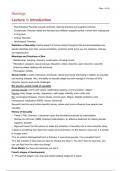College aantekeningen
International Bachelor of Psychology (IBP) elective Sexology Lecture Summary
- Instelling
- Universiteit Leiden (UL)
I studied International Bachelor of Psychology (IBP), graduated and working as a therapist. I am sharing my lecture notes from of elective Sexology. It includes lecture 1 until 7. Good luck with your exam!
[Meer zien]




